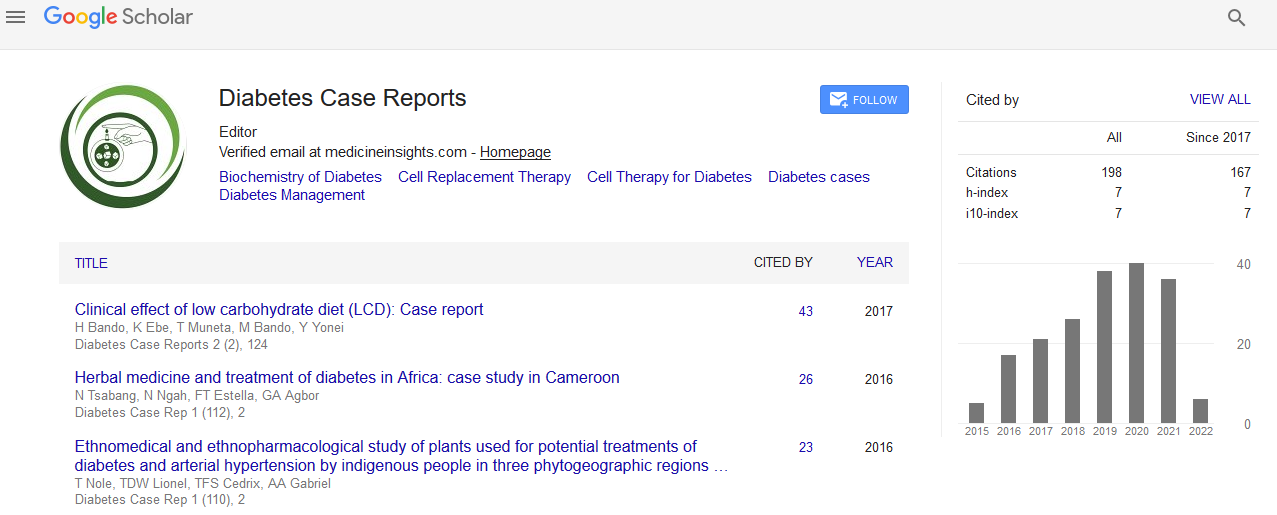Indexed In
- RefSeek
- Hamdard University
- EBSCO A-Z
- Euro Pub
- Google Scholar
Useful Links
Share This Page
Journal Flyer

Open Access Journals
- Agri and Aquaculture
- Biochemistry
- Bioinformatics & Systems Biology
- Business & Management
- Chemistry
- Clinical Sciences
- Engineering
- Food & Nutrition
- General Science
- Genetics & Molecular Biology
- Immunology & Microbiology
- Medical Sciences
- Neuroscience & Psychology
- Nursing & Health Care
- Pharmaceutical Sciences
Commentary - (2023) Volume 8, Issue 6
Dual Influence of Primary Aldosteronism on Blood Pressure and Glucose Regulation
Ann Williams*Received: 01-Nov-2023, Manuscript No. DCRS-23-24183; Editor assigned: 03-Nov-2023, Pre QC No. DCRS-23-24183(PQ); Reviewed: 23-Nov-2023, QC No. DCRS-23-24183; Revised: 01-Dec-2023, Manuscript No. DCRS-23-24183(R); Published: 08-Dec-2023, DOI: 10.35841/2572-5629-23.8.192
Description
Primary Aldosteronism (PA) has long been recognized as a disorder affecting the adrenal glands, specifically the overproduction of aldosterone. Traditionally associated with hypertension and electrolyte imbalances, the recent studies has revealed an interesting connection between PA and metabolic disturbances, particularly hyperglycemia and diabetes. This evolving understanding of the interplay between adrenal hormones and glucose metabolism has opened new avenues for research and may have significant implications for both endocrinology and cardiology. Primary Aldosteronism is a condition characterized by the excessive production of aldosterone, a hormone potential for regulating blood pressure and sodium-potassium balance. Typically, adrenal glands produce aldosterone in response to signals from the Renin-Angiotensin- Aldosterone System (RAAS). However, in individuals with PA, this regulatory mechanism malfunctions, leading to the autonomous overproduction of aldosterone.
Historically, PA has been primarily associated with hypertension, often resistant to conventional antihypertensive medications. The link between aldosterone and hypertension is wellestablished, as aldosterone promotes sodium retention and potassium excretion, resulting in increased fluid volume and elevated blood pressure. However, recent research has illuminated additional facets of PA's impact on health, including its potential influence on glucose metabolism. Several studies have suggested a potential association between PA and hyperglycemia, the hallmark of diabetes. Aldosterone, in addition to its role in sodium and potassium regulation, has been implicated in insulin resistance, a key factor in the development of type 2 diabetes. Insulin resistance occurs when the body's cells become less responsive to the effects of insulin, leading to impaired glucose uptake. The mechanisms underlying the association between PA and hyperglycemia are complex and multifaceted. One proposed mechanism involves aldosteroneinduced inflammation and oxidative stress, which contribute to insulin resistance. Aldosterone has been shown to impair insulin signaling pathways, reducing the ability of cells to respond to insulin. Additionally, aldosterone may promote the accumulation of fat in tissues, further exacerbating insulin resistance.
Clinical evidence supporting the association between PA and hyperglycemia continues to emerge. Research studies have demonstrated a higher prevalence of glucose abnormalities, including impaired glucose tolerance and diabetes, in individuals with PA compared to those with essential hypertension. Furthermore, aldosterone levels have been positively correlated with markers of insulin resistance in various populations. The intersection of PA with hyperglycemia and diabetes has significant implications for cardiovascular health. Both conditions independently elevate the risk of cardiovascular complications, and their coexistence may exacerbate this risk synergistically. Hypertension, insulin resistance, and inflammation collectively contribute to a proatherogenic environment, fostering the development of atherosclerosis and cardiovascular disease. Diagnosing the association between PA and hyperglycemia poses challenges, as the symptoms of PA may be subtle or overshadowed by those of diabetes. Routine screening for PA, typically involving aldosterone-to-renin ratio measurements, may be essential in identifying individuals at risk. A comprehensive assessment of blood pressure, electrolyte balance, and glucose metabolism is potential for a thorough evaluation. The recognition of the link between PA and hyperglycemia opens new avenues for integrated treatment strategies. While the primary focus remains on managing aldosterone excess through medications or surgical intervention, addressing metabolic abnormalities becomes equally important. Lifestyle modifications, including weight management, physical activity, and dietary interventions, may play a pivotal role in improving both blood pressure and glucose control.
Conclusion
The association between Primary Aldosteronism and hyperglycemia/diabetes underscores the intricate interplay between endocrine and metabolic pathways. Beyond its classical role inblood pressure regulation, aldosterone appears to exert significant effects on glucose metabolism, contributing to insulin resistance and hyperglycemia. As research in this field progresses, a comprehensive approach to the management of individuals with PA may become increasingly essential, encompassing not only blood pressure control but also targeted interventions to mitigate the impact on glucose homeostasis. This evolving concept holds potential for enhancing patient outcomes and transforming our approach to adrenal disorders in the context of metabolic health.
Citation: Williams A (2023) Dual Influence of Primary Aldosteronism on Blood Pressure and Glucose Regulation. Diabetes Case Rep. 8:192.
Copyright: © 2023 Williams A. This is an open-access article distributed under the terms of the Creative Commons Attribution License, which permits unrestricted use, distribution, and reproduction in any medium, provided the original author and source are credited.

